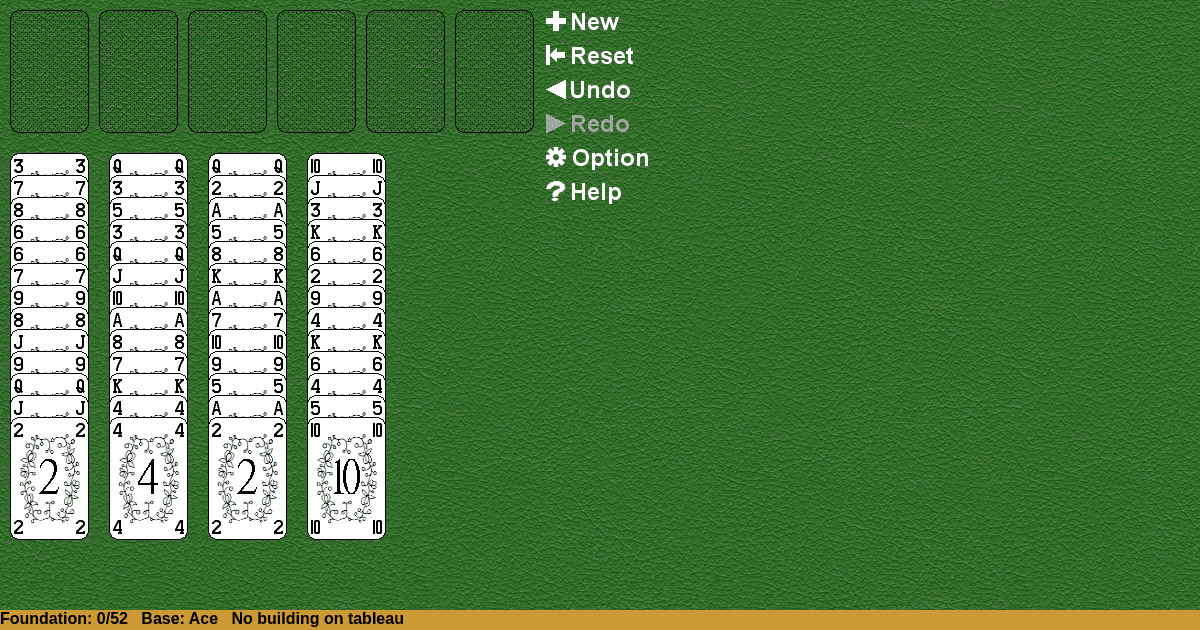Eliminator
Home |
How to play |
FAQ |
About
How to play Eliminator?
Game Objective:
The primary goal in Eliminator Solitaire is to move all 52 cards from the tableau to the foundation piles by building sequences up or down by rank, regardless of suit.
Setup & Layout:
- Deck: Uses a standard 52-card deck.
- Tableau: Four tableau piles (sometimes called columns), each containing 13 cards dealt face-up at the start of the game. All cards are visible and accessible.
- Foundations: Six empty foundation piles (occasionally four or five in some variants, but six is standard for Eliminator Solitaire).
- Key Play Areas:
- Tableau: The four piles where all cards are initially placed.
- Foundations: The six piles where cards are built up or down by rank.
- Card Orientation: All cards in the tableau are dealt face-up. There are no face-down cards in this variant.
Eliminator Solitaire Rules:
- Foundation Building:
- Any card may be placed as the first card on an empty foundation pile.
- Foundations are built either up or down by rank, regardless of suit (e.g., a 7 can be placed on a 6 or an 8, regardless of suit).
- Wrapping is permitted: Aces may be played on Kings and Kings may be played on Aces.
- Only the top card of each tableau pile is available for play to the foundations.
- Tableau Restrictions:
- No building or moving cards between tableau piles.
- Once a card is removed from the tableau, only the new top card of that pile becomes available for play.
- Foundation Restrictions:
- Cards must be placed on a foundation pile only if they are one rank higher or lower than the current top card of that pile.
- Suit does not matter; only rank order is relevant.
- Empty Tableau Columns:
- If a tableau column becomes empty, it remains empty for the rest of the game.
Gameplay:
- On each turn, the player may move any available top card from the tableau to any foundation pile, provided it is one rank higher or lower than the foundation’s current top card.
- If a foundation is empty, any tableau card may be placed to start it.
- There is no stock or reserve; all cards are in play from the beginning.
- Play continues by moving tableau cards to the foundations, following the building rules, until no more legal moves are possible or all cards are moved to the foundations.
- If no legal moves remain, the game ends and is considered lost.
Winning & Losing Conditions:
- Win Condition: The player wins by successfully moving all 52 cards from the tableau to the foundation piles, following the building rules.
- Lose Condition: The game is lost if no legal moves are possible and cards remain in the tableau.
- Unwinnable State: If tableau piles are blocked by cards that cannot be legally moved to any foundation, the game ends unsuccessfully.
Special Rules & Edge Cases:
- Empty Tableau Columns: Once a tableau column is emptied, it cannot be refilled; it remains empty for the rest of the game.
- Foundation Wrapping: Building is “around the corner,” so a King can be played on an Ace and vice versa.
- No Suit Restrictions: Building on foundations is always by rank, not by suit or color.
- No Moves Between Tableaus: Cards cannot be moved between tableau piles under any circumstances.
- Multiple Foundations: Six foundation piles provide flexibility, but careful planning is needed to avoid blocking necessary cards.
- Scoring (if applicable): Some digital versions may score one point for each card moved to a foundation, with a maximum possible score of 51. This is optional and not universal.
Summary of Key Terms:
- Tableau: The main play area with four piles of 13 face-up cards each.
- Foundation: Six piles where cards are built up or down by rank, regardless of suit, starting with any card.
- Wrapping: The ability to build from King to Ace and Ace to King.
This guide provides the precise rules and gameplay mechanics for Eliminator Solitaire as supported by multiple official and reputable sources.

Solitaire Collection
About Eliminator
Rate (Eliminator)
4.7 / 5
1,916 votes



























































